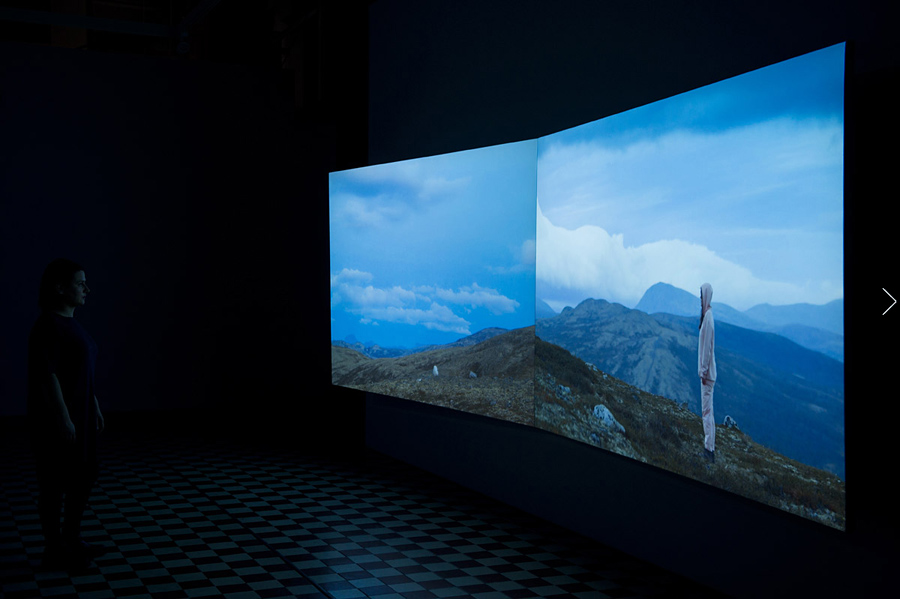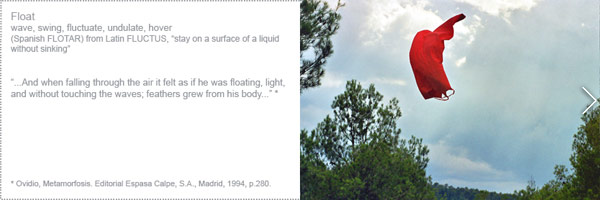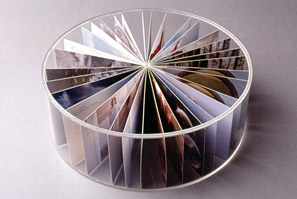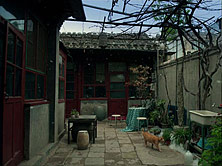PROJECTS
EARTHBOUND
One-channel spatial video installation, 9.40min, 2020

Earthbound, one-channel spatial video installation at B-gallery, Turku, Finland, 2021
Earthbound is a journey into the depths of the Earth, inside the natural material of the stone itself. In this kaleidoscopically constructed film, nature draws its own mystical story, in which human beings play a part only for a brief moment. If humans and nature are one and the same, if we evolved from the same base materials, were we perhaps born out of stone?
Science and religion also have their perspectives on how our life on Earth began, but as for how our interactions with the environment will end, nobody knows for certain.
Earthbound, one-channel spatial video installation, 9.40min, 2020
(To see the full length video, ask for password: milla@millakariinaoja.com)
HE SAID WE'D MET IN SPACE AND SUGGESTED WE TRAVEL BACK TOGETHER
Two-channel spatial video installation, 12.28min, 2020

He said we'd met in space and suggested we travel back together, two-channel spatial video installation at Gallery Huuto, Helsinki, 2020
He said we´d met in space and suggested we travel back together is a two-channel spatial video installation, centred on a man and a woman who seem to have been inserted into this multidimensional cinematic world.
Turning the camera back onto herself, the artist has constructed the film intuitively, leaving room for chance and the accidental. To be in the world is apparently to be on the brink of absurdity. The difference between real and choreographed, natural and unnatural, is not always clear. The work stems from a desire to understand the differences between our perceptions, our experiences of the world and our image of reality. What happens to our worlds when we encounter another?
Nature plays a key role, setting the boundaries that enable our very existence, both as nature and in nature. In turn, as human beings our presence – at once fragile and dominant – inevitably affects the environment.
He said we'd met in space and suggested we travel back together, two-channel spatial video installation, 12.28min, 2020
(To see the full length video, ask for password: milla@millakariinaoja.com)
BEHIND DARK CURTAINS, SNOW SEEMS TO BE WHITER

Behind Dark Curtains, Snow Seems to be Whiter, four-channel video installation at Aboa Vetus & Ars Nova, Museum of History and Contemporary Art, Turku, Finland, 2015
The four-channel video installation Behind Dark Curtains, Snow Seems to be Whiter centres around a group of abandoned wooden houses built at the end of the 19th century. Time has left its marks deep into their structures along with private events that took place decades ago and were once protected by the now crumbling walls. The artist takes part in the strange stillness of these houses with small, unassuming actions. In this photographic animation the wooden houses are both victims of a cultural change and birthplaces of new type of narratives.
The work was realized for the 7th Turku Biennial 2015 for Aboa Vetus & Ars Nova, The Museum of History and Contemporary Art in Turku, Finland.
Behind Dark Curtains, Snow Seems to be Whiter, four-channel video installation at Aboa Vetus & Ars Nova, Museum of History and Contemporary Art, Turku, Finland, 2015
Behind Dark Curtains, Snow Seems to be Whiter, four-channel video installation, 9.13min, 2015
PARALLEL INTERIORS
Three-channel video installation, 13min, 2013

Parallel Interiors, exhibition view at Photographic Gallery Hippolyte, Helsinki, 2015
Parallel Interiors takes the viewer via three parallel cinema screens into three different cities, three continents and three languages. The work realized in Beijing, Helsinki and New York is a kind of a round the world trip into scenes of people ́s ordinary daily lives. The abstract sentences flowing over the images are taken from interviews conducted by the artist in these three countries. The work examines the meaning of intimate space in a world where one's identity more and more rarely is based on the location where one lives.
The structure of the work, in which we slowly move from one place to another, engenders an experience of being simultaneously here and there. Through investigating the characteristics of different spaces and juxtaposing similar spaces with each other, Oja attempts to observe what connects the spaces together, not architecturally or materially, but on an emotional level.
Text – Hanna Johansson
Parallel Interiors, three-channel video installation at Photographic Gallery Hippolyte, Helsinki, 2015
Parallel Interiors, three-channel video installation, time-lapse animation, 12.30min, 2013
FALLING HOUSE
Time-lapse animation, 1.40min, 2013

Still photos from 'Falling House' video, time-lapse animation, 1.40min, 2013
Falling House shows the destruction of a two-storey residential building. An orange digger tears down the load-bearing walls of a building. Finally the house collapses to the ground. The work was shot in South China by using time-lapse photography, which enables the artist to show a longer period of time over just a few minutes as a direct shot without cuts.
Falling House shows the facades of a dwelling and their crumbling from the outside. Unlike In Conversation with Seven Flowers and Others the artwork doesn't talk about the inhabitants, neither does it raise questions about their experiences. Oja's depictions of mechanical violence towards residential buildings appear as societal indifference to people's daily lives, the lived history of the dwellings and the layers of memory pertaining to them.
Text – Hanna Johansson
Falling House, time-lapse animation, 1.40min, 2013
IN CONVERSATION WITH SEVEN FLOWERS AND OTHERS
Time-lapse animation, 9.11min, 2013

Still photos from 'In Conversation with Seven Flowers and Others' video, 2013
In Conversation with Seven Flowers and Others shows the viewer an intimate side of dwelling. The video work is like of a present day milieu portrait. The image follows the daily routines of a young Chinese woman in her own room and balcony over the course of one day, from daytime till night, until the dark. The woman performs ordinary daily tasks; waters plants, drinks tea, irons some dresses, lights up a cigarette and browses on an iPad. She lives alone and enjoys her home.
Alongside the gestures of the woman we hear about little incidences related to the subject of home taken from stories of interviewees. These detached sentences do not form a full story and they are not directly connected to the images, but yet they clearly relate to home, dwelling and the mood of a place. Intimate spaces allow secrets to be shared and agreements made in public can be broken.
Text – Hanna Johansson
In Conversation with Seven Flowers and Others, time-lapse animation, 9.30min, 2013
HOME-PROJECT
A series of photographs and a three-channel video installation, 2010

From the home series – Concrete, C-print mounted on aluminium with plexiglass, 50x75, 2010
Home-Project is a series of works that reflect on a notion of home. Oja studies the vital space of human beings by photographing the universal and even a clichéd "image" of a house. She places a simple house-shaped model made out of wood and fabric in different locations to observe the relationship between the house and the chosen place. The house appears in various Chinese outdoor settings – on mountains, in the middle of a desert, on the outskirts of a Chinese city, and in Finland by lakesides and in forests.
The series consists of 14 medium and large-scale photographs and a three-channel video installation. The videos record the locations where the houses were previously photographed, and then removed, leaving empty landscapes.
Recordings on Empty Spaces, three-channel video installation, looped, 2010
CAT'S CRADLE
DV video and a series of photographs, 2005-2006

Still images from the video Cat´s Cradle, 12.40 min, 2005
This series of works is based on a children's string-game called Cat's Cradle, where two participants make figures in their hands with a cotton string. The string is moved from one participant to the other while the game goes on and the figure changes its shape. One has to make the movements right, otherwise the string gets knotted up and the figure doesn't come out the right way.
The project consists of a series of photographs and a video, where eight participants walk around with a long string making all the figures of the game, one after another.
Cat's Cradle, DV video, 12.40 min, 2005

Dimitris and Eva, C-print mounted on aluminium, 111x150cm 2005
DICTIONARY OF THE UNREACHABLE CONCEPTS
Circular shaped book and a series of photographs, 2003

The Dictionary of the Unreachable Concepts, Height 9,5 cm, Diameter 29 cm, laser print on paper, acrylic plastic, 2003

Page spreads from the Dictionary

Page spreads from the Dictionary (Original Spanish version)
The Dictionary of the Unreachable Concepts is a collection of words and images in the form of a circular book. 16 words together with various series of photographs deal with the desire to fly, to reach the unreachable in life, where the fear to fail and fall is always present.
The circular form is a form that never ends – a book without a beginning and without an end. The spectator can decide where to start, never being closer or further off the end, but always in the middle. This notion of "being in between" manifests itself in the desire to fly, always intrinsic to its counterpart, the fall.
The book was originally written in Spanish. It quotes from dictionaries of symbolism, philosophy and etymology, and from books such as The Water and the Dreams by Gaston Bachelard, Metamorfosis by Ovidio, Alice in Wonderland by Lewis Carroll.

From The Dictionary of the Unreachable Concepts, C-print mounted on aluminium with plexiglass, 50x75cm, 2003
































